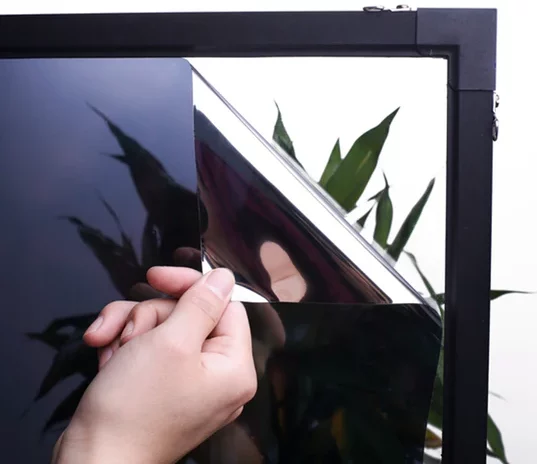When businesses look to implement temporary window graphics or promotional signage, two popular materials often come into consideration: static cling window film and low tack adhesive film. Both serve the purpose of easy-to-install, semi-permanent window displays. However, the decision between cling static materials and pressure-sensitive adhesive films can significantly impact the performance and longevity of your signage. Understanding the characteristics, strengths, and drawbacks of both options is essential for making the right choice for your application, especially when comparing static cling vs adhesive window film.
Understanding Static Cling Window Film
What is static cling window film? Static cling window film is a vinyl material that adheres to smooth surfaces without the use of traditional adhesive. Contrary to what the name suggests, static cling does not rely on static electricity. Instead, the film clings due to the cohesive forces created by plasticizers in the vinyl, which enable the material to bond temporarily with similarly smooth surfaces. This makes it ideal for window film adhesive applications on glass windows, display cases, mirrors, and other non-porous surfaces.
This type of material is especially common in temporary store promotions, seasonal window decorations, and automotive interior applications such as static cling automotive window tint. The reusable and adhesive-free nature of cling-on window film makes it highly appealing for businesses looking for a flexible, cost-effective signage option that doesn’t leave residue behind.
Advantages of Using Static Cling Films
One of the biggest benefits of using window film static cling is that it does not contain any adhesive. This feature makes it reusable in many cases, as long as the material is kept clean and stored properly. Because static cling films are usually thicker than adhesive films—often around 8 mil—they are easier to handle and apply, especially for non-professional staff.
Additionally, these materials are more forgiving during installation. How to install static cling window film is also simpler compared to adhesive films since cling static films can be repositioned easily and removed without tools, chemicals, or risk of damage to the glass surface. This makes them particularly user-friendly for retail staff or event teams working on limited timelines. From a budgeting perspective, printable window cling materials are generally less expensive than low tack adhesive alternatives, making them ideal for short-term marketing campaigns or frequently changing graphics.
Limitations of Static Cling Window Film
Despite their advantages, static cling window film materials do have limitations. Their effectiveness is highly dependent on both the cleanliness of the surface and the film itself. Even small amounts of dust, oil, or moisture can reduce the film’s ability to cling properly.
Another drawback is the relatively short shelf life. If unused for an extended period, the plasticizers in the vinyl may lose their effectiveness, rendering the film unusable. In most cases, the shelf life is around six months under ideal storage conditions.
Performance in cold or humid environments is also a concern. When used in settings such as retail freezer doors or car windows, cling-on tinted window film may begin to sag or lose adhesion. This is especially true in regions with fluctuating humidity or during the winter months. In addition, if large areas of the film are covered with ink during printing, the film’s ability to cling may be compromised. Finally, because the film relies on cohesive force, only smooth surfaces like glass or polished plastic are compatible, which limits its versatility in broader applications.
Exploring Low Tack Adhesive Films
Low tack adhesive films, often incorrectly referred to as “clings,” use a pressure-sensitive window film adhesive that forms a light bond with the application surface. This type of film offers broader compatibility with different surface textures and is often used where window film static cling would be ineffective.
These materials are popular in environments that require more reliable adhesion over longer periods or on non-glass surfaces. They can be produced as printable window cling alternatives and are suitable for both indoor and some short-term outdoor uses, depending on the adhesive formulation.
Benefits of Low Tack Adhesive Films
One of the most notable benefits of low tack adhesive films is their ease of customization. These films are easier to print, coat, and die-cut during production, which can significantly streamline operations for manufacturers and resellers. They also provide a stronger initial bond than cling static films and can be applied to a much wider range of surfaces including walls, plastics, and metals.
From a durability standpoint, low tack adhesives are better equipped to handle environmental factors such as temperature changes and humidity. These materials tend to have a longer shelf life and are less sensitive to storage conditions compared to tinted static cling window film options. For business applications that require reliable performance in diverse settings, this can be a decisive factor.
Drawbacks of Low Tack Adhesive Films
Although versatile, low tack adhesive films are not without their challenges. They are typically thinner than static cling window film, which can make them more difficult to handle during installation. Their adhesive nature also means they are more prone to sticking to themselves, which can complicate the application process.
Once removed, these films generally cannot be reused. Additionally, over time and under certain environmental conditions, the adhesive bond can strengthen, making the material more permanent than intended. This could pose issues during removal, particularly if the film was not designed for long-term use. Cost is another consideration—low tack adhesive films tend to be more expensive than cling on window film, especially for large-scale rollouts or frequently changed graphics.
Making the Right Choice for Your Application
The choice between static cling vs adhesive window film depends on several factors, including surface type, duration of use, environmental exposure, and installer experience. If your application involves short-term indoor signage on clean glass, window film static cling may be the most cost-effective and flexible solution. On the other hand, for applications that require stronger bonding, varied surface compatibility, or outdoor use, low tack adhesive materials may provide better overall value and performance.
For example, a retailer updating monthly promotions could benefit from printable window cling with static properties, while a business needing signage for an aluminum door or painted wall may find better results with low tack adhesive. Similarly, car dealerships or service centers using static cling automotive window tint must consider humidity, temperature, and shelf life when choosing between options.
Whether you’re sourcing materials for cling static signage, planning a seasonal marketing campaign, or outfitting multiple storefronts with cling-on tinted window film, it’s important to weigh both the pros and cons of each film type. Static cling materials offer simplicity, ease of use, and reusability, while low tack adhesive films provide better surface compatibility and durability.
By carefully evaluating the environment, surface type, expected duration, and handling requirements, you can choose the window cling solution that best aligns with your business needs. Selecting the right material can reduce installation errors, minimize waste, and maximize the impact of your window graphics—especially when navigating the comparison of static cling vs adhesive window film and understanding how window film adhesive performs in various scenarios.





